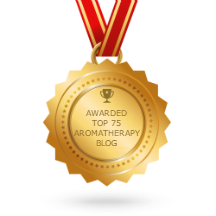One of
the most frequent conversation starters in the aromatherapy community is “what
does it smell like?” One of the most
frequent answers is, “Oh, …I can’t really describe it!”.
Previously, it was thought that the human nose
could only detect 10,000 scents. But in
2014, neurobiologist Leslie Vosshall of Rockefeller University in New York
City, led research that found that the human nose is able to smell a trillion
scents, with varied individual responses. The
researchers calculated that the least successful smeller in the study would be
able to smell only 80 million unique scents. And the best performer had a far
more sensitive sense of smell, likely able to distinguish more than a thousand
trillion odors. (1)
Ironically, even though we can smell them, we
aren’t always able to identify or describe them. Part of the equation, of course, is prior
experience. If we haven’t come into
contact with a certain aroma before, there is obviously no way we can identify
it. But there is another element
involved that the human nose simply has difficulty doing – deconstructing
scent. For example, Robert Tisserand cited
that “Essential oils typically contain dozens of constituents with related, but
distinct, chemical structures.” (2) How many could pick out each
and every constituent from one oil? What
if it were a blend of multiple oils, with similar, but not quite the same,
constituents?
As in the
example of peanut butter, given in PBS article “Why We’re Good at Identifying
Smells, But Horrible at Describing Them”, roasted peanuts give off roughly 200
air molecules, peanut oil, 100. (3)
In an
experiment at Northwestern University, participants were fed a large amount of
peanut butter, they were then asked to describe peanut
butter. Scans indicated a change in
neural activity in the region of the brain designed to identify odors and
associating them with similar smells – the posterior piriform cortex. This is
the first stop that olfactory information makes in the brain after the
olfactory bulb, suggesting that a decrease in a smell’s value may start at the
level of perception. Participants
reported finding the smell of peanut butter less pleasing after having eaten
such a large amount of it. (3) I
recently asked Mark Webb how people can claim to love the smell of coffee
report disliking the taste. Mark
explained to me that coffee contains bitters that we are not able to smell.
Likewise,
there is the connection between smell and memory/emotion. If a scent evokes a pleasant memory, perhaps
a grandmother’s lavender scent or baking cookies, this will be a pleasant
memory/emotional response. I’ve often mentioned
the natural gas sub station near my home that every time I pass it and breath
in, I am reminded of being at my great-grandmother’s house – 45 years ago. So while that pungent odor is repelling to
many, it tickles my subconscious to remember a special person, long gone. A strong floral aroma may remind some of
working in their garden or a gift from an admirer, while for others, it may
trigger emotions left over from a loved one’s funeral.
Some have
asked why they “taste” essential oils while pouring, without ever having put
the oil in their mouth. This is because
the two senses are actually interactive.
Both are considered “chemsensations”, occurring when molecules are
released, stimulating nerve endings in the nose, mouth or throat. These cells transmit data to the brain, where
tastes and smell are identified. Olfactory cells, found in a tiny patch of
tissue high up in the nose, are stimulated by odor. Gustatory cells, clustered in the taste buds
of the mouth and throat, react to taste mixed with saliva. Some of the tiny bumps that can be seen on
the tongue contain taste buds. All send
messages to the brain of what they are experiencing. (4) As these areas are so close together and
interactive, molecules that we breath in, Mark Webb explains, can pass over the
taste receptors as well.
When,
for example, nasal congestion sets in, there is an interruption of air flow
passing over the olfactory receptors, preventing odorous compounds from
reaching them, interrupting our sense of smell.
Although the stimulation of taste receptors is not affected, the loss of
smell alters the flavors we perceive. (5)
I
recently mentioned someone else’s description of an essential oil as “sweet,
woody.” Imagine my reaction when her
only response was “PICKLES!!” So the
next time you ask, “What does that smell like?” remember that smell is not
always unbiased. It is strongly affected
by experience, memories and emotion.
My comments: We see this in some clients reactions to products. I have seen long conversations on Facebook when someone has referred to a product as smelling like "cat pee" and other will jump in stating how lovely it is. Which indicates to me that the same aroma will be experienced differently by different people, above and beyond the emotional triggers Sandy mentions above.
Another issue when it comes to describing the aroma of a specific oil or botanical is that our society ignores olfactory stimulus, and we haven't developed the language to accurately describe the fine differences between, for example, Cedrus atlantica and Cedrus deodara. I know that in writing about our products I am forced to use the language of music, of color, of flavor, to describe, in our language, doesn't exist.



1 comment:
Great Read! Thank you for your article Sandy.
Post a Comment